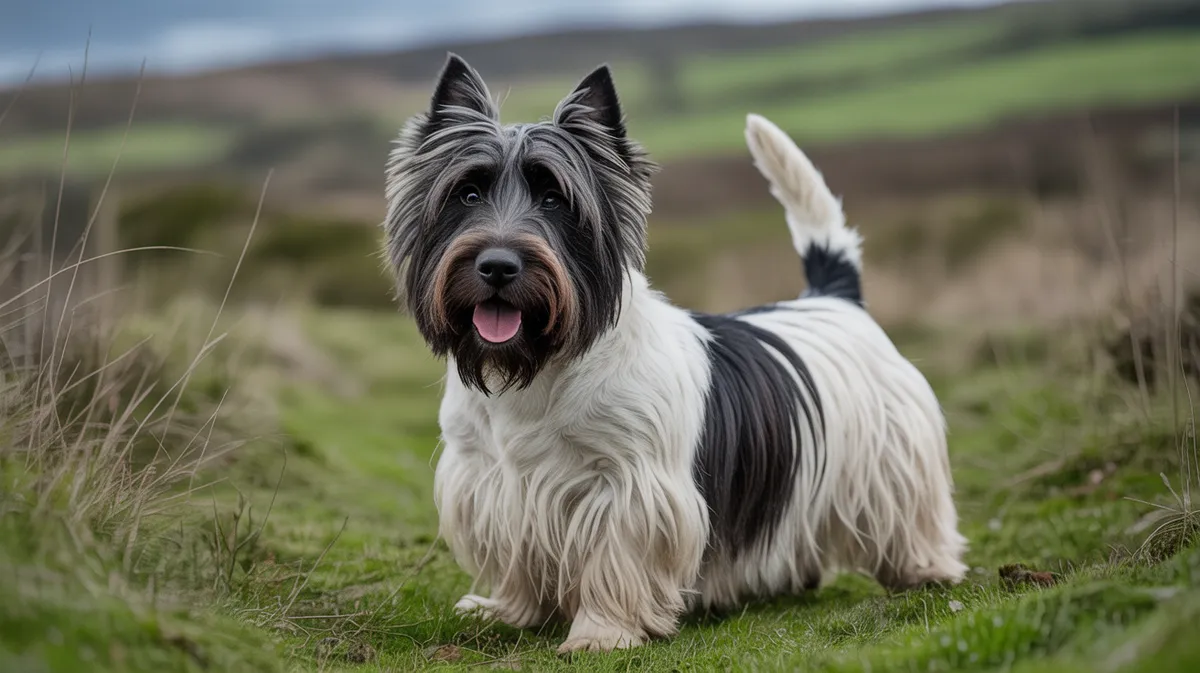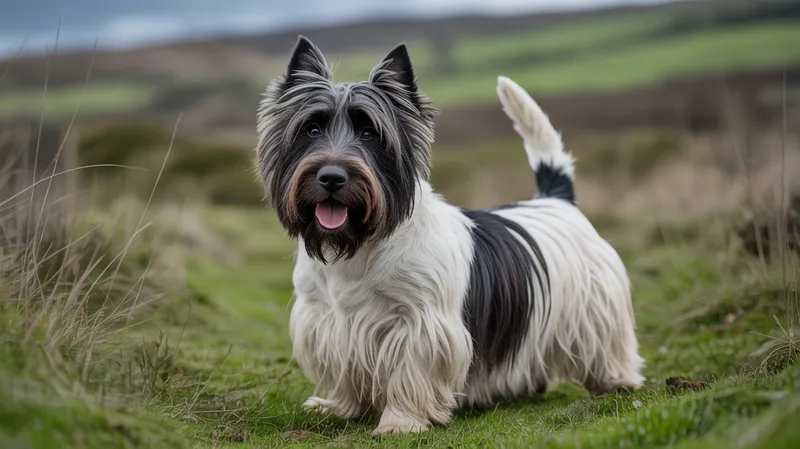
Skye Terrier
Canis lupus familiaris

Meet the Skye Terrier
The Skye Terrier is a distinctive and elegant breed of dog originally bred on the Isle of Skye in Scotland. Notable for its long, flowing double coat and low, elongated body, this terrier was developed to hunt foxes and badgers in rocky terrain. Skye Terriers are known for their loyalty and affectionate nature toward their owners, but can be reserved with strangers. Despite their small stature, they are brave and spirited, with a history as both working dogs and favored companions of Scottish nobility.
Classification
Mammal
Habitat
Domestic; originally rugged countryside and farmlands
Diet
Omnivore
Lifespan
12-15 years
Conservation
Vulnerable
Weight
16-23 kg (35-51 lbs)
📖Fascinating Facts
Scottish Heritage
The Skye Terrier originates from the Isle of Skye in Scotland, giving the breed its distinctive name and rugged characteristics.
Unique Appearance
With a long, low-set body and a luxurious double coat, the Skye Terrier stands out among terrier breeds for its elegance and unique silhouette.
Endangered Breed
The Skye Terrier is considered one of the most endangered native dog breeds in the UK, with very low annual puppy registrations.
📋Detailed Description
The Skye Terrier is a small, sturdy terrier breed distinguished by its elongated, low-set body and profuse double coat, which can reach the ground and provides protection against harsh weather and rough terrain. Adults typically stand 23–26 cm (9–10 in) at the shoulder and weigh between 16–18 kg (35–40 lbs), with females slightly lighter than males. The breed's head is long and powerful, featuring a strong jaw, well-developed muzzle, and expressive dark brown eyes that convey intelligence and alertness. Ears may be either prick (erect) or drop (folded), both historically accepted, and are heavily feathered. The Skye Terrier's tail is long and feathered, carried low or slightly curved. This breed is known for its dignified, reserved demeanor, yet forms deep bonds with its family, often displaying intense loyalty and affection. Skye Terriers are independent thinkers, a trait inherited from their working origins, and can be wary of strangers. Their movement is characterized by a unique, effortless gait, with a long stride despite their short legs. The breed's dense undercoat and hard, straight outer coat serve as insulation and protection while traversing rocky Scottish landscapes. Skye Terriers are generally healthy but can be prone to specific hereditary conditions such as degenerative disc disease due to their elongated spine.
💡 Did you know?
The famous Skye Terrier named Greyfriars Bobby is celebrated in Edinburgh for his legendary loyalty, having guarded his owner's grave for 14 years.
🔬Research & Sources
Wikipedia Summary
The Skye Terrier is a Scottish dog breed that is a long, low, hardy terrier with short legs. It is "one of the most endangered native dog breeds in the United Kingdom" according to the Kennel Club.
Last Modified: 3/5/2025
🎭Behavior & Social Structure
Skye Terriers are alert, courageous, and tenacious, reflecting their historical role as vermin hunters. They display a strong prey drive, often chasing small animals if not properly socialized. While affectionate and devoted to their owners, they can be aloof or suspicious toward unfamiliar people and animals, making early socialization crucial. They are not typically pack-oriented but form close attachments to their family, sometimes favoring one person. Skye Terriers are intelligent and can be independent or stubborn, requiring patient, consistent training with positive reinforcement. They enjoy moderate exercise, including daily walks and play sessions, but are not excessively energetic. Their keen senses and alertness make them effective watchdogs, often vocalizing when something unusual occurs. Indoors, they are calm and content, preferring to stay close to their chosen humans.
👶Reproduction & Life Cycle
Skye Terriers reach sexual maturity between 8–12 months, though responsible breeding is recommended after 18 months of age. The breed typically has one heat cycle per year, with the optimal breeding season in late winter to early spring. Gestation lasts approximately 63 days. Litter sizes are small, averaging 3–6 puppies. Neonates are born with closed eyes and ears, relying entirely on maternal care. The dam provides intensive care for the first three weeks, after which puppies begin to explore and socialize. Weaning occurs around 6–8 weeks. Skye Terrier mothers are attentive and protective, and breeders often monitor for signs of dystocia due to the breed's body shape. Puppies require early handling and socialization to develop balanced temperaments.
🛡️Adaptations & Survival
The Skye Terrier's long, low body and short, robust legs are evolutionary adaptations for pursuing prey into narrow crevices and burrows among rocky Scottish landscapes. Its dense, weather-resistant double coat insulates against cold, damp climates and protects from brambles and rough terrain. The breed's strong jaw and teeth are suited for gripping and dispatching vermin. Their acute sense of smell and hearing aid in detecting hidden prey. Behaviorally, their independence and wariness of strangers are adaptive traits for working alone or in challenging environments. Their loyalty and strong bond with owners may have been selected for in their dual role as both working dogs and companions.
📚Research Sources
🎨Cultural Significance
The Skye Terrier holds a notable place in Scottish history and folklore. It was favored by 19th-century British nobility, including Queen Victoria, who helped popularize the breed. The most famous Skye Terrier is Greyfriars Bobby, celebrated in Edinburgh for his legendary loyalty, having guarded his master's grave for 14 years; a statue and memorial commemorate him. The breed has appeared in literature and art, symbolizing fidelity, courage, and devotion. While no longer widely used for hunting, Skye Terriers remain cherished as companion animals and are featured in dog shows and heritage events.
🔬Recent Research & Discoveries
Recent genetic studies have focused on the Skye Terrier's limited gene pool and the prevalence of hereditary conditions such as degenerative disc disease and autoimmune disorders. Ongoing research aims to map the breed's genome to identify risk alleles and inform breeding strategies. Studies on canine behavior have highlighted the Skye Terrier's unique combination of independence and attachment, providing insights into the effects of selective breeding for both working and companion roles. Conservation organizations are collaborating with breed clubs to monitor population trends and promote best practices in breeding and health screening.
🎥Wildlife Videos

Tales of Loyalty : Dog , Man's Best Friend !
If you're a dog lover, you need to hear these tales! Stories of loyalty and bravery that will melt your heart. Meet Bobby, the Skye ...
onetickettofreedom

Wolfdogs on the Isle of a Skye
Into the wild 2110

Fizo the Wonder Dog
Eight year old Sydney terrier, Fizo, became the first animal in Australia to win the RSPCA's Purple Cross award for bravery, after ...
AnimalXTV mysteries and paranormal

wolves of the sky 7
harris hawks huting rabbits with ferrets.
cetreria en estado puro

Secret Creatures: Africa's earth pig, the Aardvark.
It is several hours after sunset. Countless stars dot the wide black African sky, and in the darkness, a strange sound emanates ...
Lion Mountain TV
🌍Habitat Information
The Skye Terrier typically inhabits Domestic; originally rugged countryside and farmlands environments. Skye Terriers have adapted to their environments with specialized features and behaviors.
Primary Habitat:
Domestic; originally rugged countryside and farmlands
More detailed habitat information will be available soon.
🛡️Conservation Status
The Skye Terrier is currently classified as Vulnerable. Conservation efforts are crucial for preserving this species for future generations.
Common Threats:
- 🏠Habitat loss and fragmentation
- 🌡️Climate change impacts
- 🎯Hunting and poaching
- 🏭Human-wildlife conflict
⚠️Threats & Conservation Challenges
The Skye Terrier is classified as one of the most endangered native dog breeds in the United Kingdom, with annual registrations often below 50 puppies. Major threats include a shrinking gene pool, low public awareness, and competition from more popular breeds. Urbanization and changes in land use have reduced the need for traditional vermin-hunting terriers, further diminishing demand. The breed's unique appearance and temperament, while appealing to enthusiasts, may deter casual pet owners. Genetic bottlenecks increase the risk of inherited diseases, and responsible breeding is essential to maintain health and diversity. Conservation efforts focus on education, promoting responsible ownership, and encouraging genetic diversity through careful breeding programs.
🔬Scientific Classification
Scientific Name
Canis lupus familiaris
Classification Hierarchy
🔍 About Taxonomic Classification
Taxonomic classification is a hierarchical system used by scientists to classify and organize living organisms based on shared characteristics and evolutionary relationships.
The system moves from broad categories (Kingdom) to increasingly specific ones, with each animal's scientific name typically consisting of its Genus and species.
📝Community Notes
Share your observations and insights about the Skye Terrier with our community of wildlife enthusiasts.
Join Our Community
Sign in to share your observations and connect with fellow wildlife enthusiasts.
Sign In to ContributeNo community notes yet
Be the first to share your observations about the Skye Terrier!
Explore Skye Terrier
Select a tab above to learn more about this amazing animal.
📸Photo Gallery
No photos available for this animal yet.
🌟Discover More Wildlife
Continue your journey of discovery with more fascinating animals from our database
